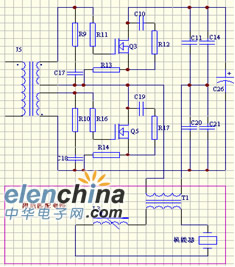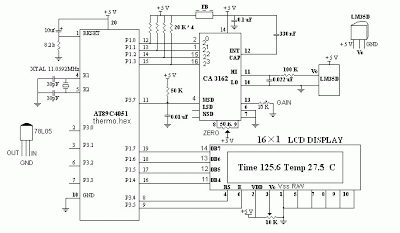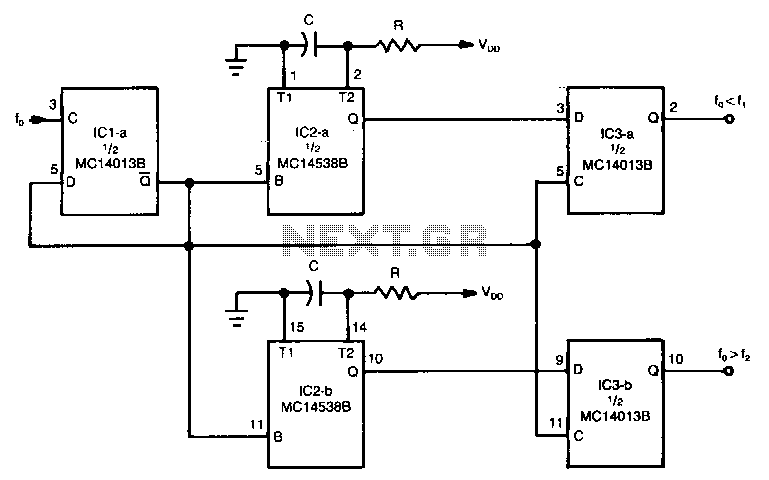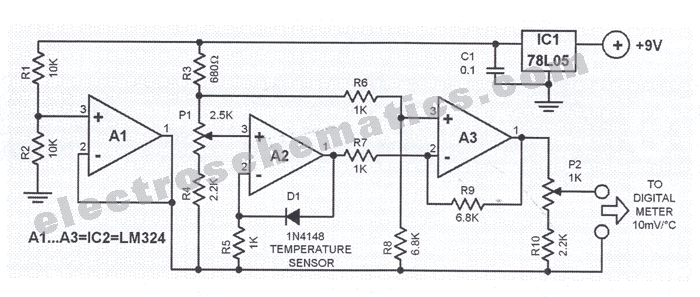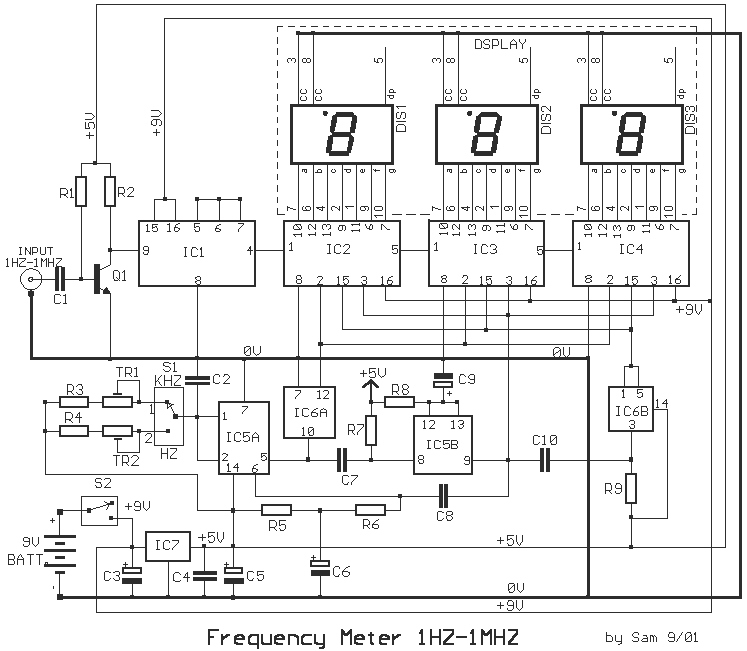
Frequency meter - LC measuring instrument

The frequency meter described not only serves its primary function but also allows for the measurement of inductance in various coils, resonant frequency of circuits, and capacitance of capacitors. The schematic diagram of this combined device is illustrated in Figure 1, making it a valuable tool for radio enthusiasts and designers. The construction of this device does not require rare components, and it is straightforward to adjust and operate. The device can measure signal frequencies with amplitudes ranging from 0.1 to 5V, whether sinusoidal or square, across a frequency range of 50 Hz to 500 kHz, as well as inductance from 4.5 μH to 1 H. For ease of reading, the measurement range is divided into four sections. The first section is for frequency measurements up to 500 Hz, the second is for frequencies from 500 Hz to 5 kHz or inductance from 40 μH to 1 H, the third covers frequencies from 5 to 50 kHz with inductance values from 0.4 μH to 40 μH, and the fourth is for frequencies from 50 to 500 kHz and inductance values from 4 μH to 400 μH. The necessary range is set using switch SA2, while the measurement mode (frequency or inductance) is selected using switch SA1. The frequency measurement error does not exceed 5%. The operational principle of the frequency meter is based on converting the input signal into a sequence of rectangular pulses with stable duration and amplitude, followed by measuring the average current of this sequence using a microampermeter. The operation of the frequency meter is illustrated in Figure 3. The input signal (Figure 3a) is fed into a buffer stage built with transistor VT1, which ensures high input resistance and minimal input capacitance. The output from this stage passes through section SA1.1 of switch SA1 to a converter made with elements DD4.1 and DD4.2. This converter transforms any input signal into a sequence of rectangular pulses that exit from element DD4.2 and are sent either directly to the input of inverter VT2 (if the first range is selected) or to the input of a frequency divider made with counters DD1 to DD3 (for other ranges). Each counter divides the input signal frequency by 10, ensuring that the pulse sequence frequency at the inverter transistor input does not exceed 500 Hz. The inverter DD4.3 and element DD4.4 create stable amplitude and duration pulses. The high-level voltage from the collector of transistor VT2 (Figure 3b) is applied to the input of inverter DD4.3 and to the integrating circuit formed by resistors R8, R9 and capacitor C6. The upper input of element DD4.4 receives low-level voltage (Figure 3g), while the lower input receives high-level voltage (Figure 3c) but with a time delay that depends on the time constant of the integrating circuit. The duration of this delay is adjusted using the tuning resistor R8, which also defines the pulse duration at the output of element DD4.4 (Figure 3μ). The average current of the pulse sequence is measured by microampermeter PA1, and this current is proportional to the frequency of the input signal. For inductance measurement, switch SA1 is set to the "L" position. The converter using elements DD4.1 and DD4.2 acts as a generator, with its frequency determined by the capacitance of capacitor C2 and the inductance of coil L, which connects to terminals ¥2 and ¥3. The frequency is measured by the frequency meter (as described above), and inductance is calculated using the formula: L = 1/fU², where L is in μH and f is in MHz. For convenience, the device scale can be additionally calibrated in inductance values or separately produced for other applications.Feature of an offered frequency meter that he besides the main function allows to define inductance of various coils, resonant frequency of contours, capacity of condensers. The combined device which schematic diagram is shown on fig. 1 becomes the good assistant to the radio fan designer. For its manufacturing scarce details are not required, it is simple in adjustment and in operation. The device it is possible to measure frequency of signals by amplitude 0, 1. 5 In sinusoidal or squared in a range from 50 Hz to 500 kHz, and also inductance from 4 ½ to 1 Gn. For convenience of counting of indications the working range of values is broken into four ° ° · ½ °. The first of them establish at frequency measurement to 500 Hz. The second - at frequency measurement from 500 Hz to 5 kHz or inductance from 40 ½ to 1 Gn. The third - at frequency of a signal from 5 to 50 kHz, values of inductance 0, 4. 40 ½. And the fourth poddiapazon-at frequency of a signal from 50 to 500 kHz and values of inductance 4. 400 ½. Necessary ° ° · ½ establish the SA2 switch, and a mode of measurements (frequency or inductance) - SA1.
The error of measurement of frequency does not exceed 5 %. The principle of work of a frequency meter is based on transformation of an entrance signal to sequence of rectangular impulses with stable duration and amplitude and the subsequent measurement by the microampermeter of average value of a current of this sequence. Simply work of a frequency meter explain ‹, given on fig. 3. A studied signal (fig. 3, and) submit on an entrance of buffer knot which is executed on the VT1 transistor. Purpose of knot - to provide big entrance resistance and the minimum entrance capacity of a frequency meter.
From a knot exit the signal arrives through the SA1 switch section SA1. 1 on the converter executed on the elements DD4. 1, DD4. 2. It serves for formation from an entrance signal of any form of sequence of rectangular impulses which from an element DD4. 2 exit (fig. 3, ) arrive or is direct on an inverter entrance on the VT2 transistor (if to establish the first ° ° · ½), or on an entrance of a divider of frequency (at work on others ° ° · ½ ° …), executed on DD1 counters - DD3.
Each of counters divides frequency of an entrance signal on 10 therefore irrespective of the fact which it is established ° ° · ½, frequency of sequence of impulses on an entrance of the transistor inverter will be no more than 500 Hz. On the DD4. 3 inverter and the element DD4. 4 the shaper stable on amplitude and duration of impulses is executed. Tension of high level from a VT2 transistor collector (fig. 3, in) arrives on an entrance of the DD4. 3 inverter and on integrating chain of R8 R9 C6. On top according to the circuit an entrance of the element DD4. 4 tension of low level (fig. 3, g), and on its bottom entrance - high (fig. 3, ), but with a temporary delay which depends on a sign of a constant of time of an integrating chain is established.
Duration of a delay regulate the tuning R8 resistor, and its value defines duration of impulses of t on an element DD4. 4 exit (fig. 3, µ). Average value of a current of sequence of these impulses measure by means of the PA1 microampermeter.
Value of a current proportionally to frequency of an entrance signal. And how the inductance measuring instrument works For this mode the SA1 switch transfer to situation "L". The converter on the elements DD4. 1, DD4. 2 turns into the generator which frequency is defined by value of capacity of the C2 condenser and inductance of the L … coil - it connect to nests ¥2, ¥3.
Value of frequency measure by a frequency meter (its work is described above), and inductance calculate on a formula: L … = 1/fU2, where L … - in ½, a f - in MHz. For convenience of counting a scale of the device it is possible in addition ³ ° ƒ ² ° ‚ in values of inductance or to make separately for ever
🔗 External reference
The error of measurement of frequency does not exceed 5 %. The principle of work of a frequency meter is based on transformation of an entrance signal to sequence of rectangular impulses with stable duration and amplitude and the subsequent measurement by the microampermeter of average value of a current of this sequence. Simply work of a frequency meter explain ‹, given on fig. 3. A studied signal (fig. 3, and) submit on an entrance of buffer knot which is executed on the VT1 transistor. Purpose of knot - to provide big entrance resistance and the minimum entrance capacity of a frequency meter.
From a knot exit the signal arrives through the SA1 switch section SA1. 1 on the converter executed on the elements DD4. 1, DD4. 2. It serves for formation from an entrance signal of any form of sequence of rectangular impulses which from an element DD4. 2 exit (fig. 3, ) arrive or is direct on an inverter entrance on the VT2 transistor (if to establish the first ° ° · ½), or on an entrance of a divider of frequency (at work on others ° ° · ½ ° …), executed on DD1 counters - DD3.
Each of counters divides frequency of an entrance signal on 10 therefore irrespective of the fact which it is established ° ° · ½, frequency of sequence of impulses on an entrance of the transistor inverter will be no more than 500 Hz. On the DD4. 3 inverter and the element DD4. 4 the shaper stable on amplitude and duration of impulses is executed. Tension of high level from a VT2 transistor collector (fig. 3, in) arrives on an entrance of the DD4. 3 inverter and on integrating chain of R8 R9 C6. On top according to the circuit an entrance of the element DD4. 4 tension of low level (fig. 3, g), and on its bottom entrance - high (fig. 3, ), but with a temporary delay which depends on a sign of a constant of time of an integrating chain is established.
Duration of a delay regulate the tuning R8 resistor, and its value defines duration of impulses of t on an element DD4. 4 exit (fig. 3, µ). Average value of a current of sequence of these impulses measure by means of the PA1 microampermeter.
Value of a current proportionally to frequency of an entrance signal. And how the inductance measuring instrument works For this mode the SA1 switch transfer to situation "L". The converter on the elements DD4. 1, DD4. 2 turns into the generator which frequency is defined by value of capacity of the C2 condenser and inductance of the L … coil - it connect to nests ¥2, ¥3.
Value of frequency measure by a frequency meter (its work is described above), and inductance calculate on a formula: L … = 1/fU2, where L … - in ½, a f - in MHz. For convenience of counting a scale of the device it is possible in addition ³ ° ƒ ² ° ‚ in values of inductance or to make separately for ever
🔗 External reference
